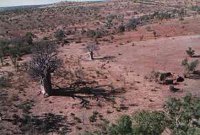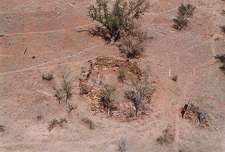
Kachana Historical

Kachana Historical

 |
We looked everywhere for the ruins, but because the grass was very high and thick we did not find the ruins. We walked north until we found a good sandy area with lots of thick trees close to the Salmond River. There we made camp. We collected lots of firewood and also heaps of leaves for our bed. We made a huge fire, had dinner and went to bed with Mischa cuddled between us. Luckily it did not rain. Woke up on Wednesday the 14/2/2001 and had a quick breakfast. Packed up everything and headed more north to look for ruins again. We noticed we were in Gouldian Finch country, so headed back south. Lee and I thought we heard a Gouldian Finch. |
| After a while Dean Spotted the ruins on top of the next hill, so we walked down the hill we were on, and walked to the next hill, crossed the creek and walked towards the big boab in front of us. On the way we saw an old fence. Then we went to the Boab. We saw names engraved on the boab so we wrote them down in our notebooks. When we finished we left our bags at the boab and walked to the round building. On the round ruin we saw an old bucket and some old tree stumps with wire. On the wall we noticed an old hook and some other metal objects. Outside the ruin was some aluminum (not from the Afghans, but from people who settled there later). |
 |
 |
Inside the square ruin was grass growing and outside we saw glass, wire and metal. Bobby found three glass scrapers worked by Aboriginal. When we finished studying the square ruin and its contents we made our way back. At the creek we had lunch then we walked over the hill. On the top we discovered a quarry site made out of quartzite. We walked down hill and into a valley. Found a track and crossed the creek and walked to Barra Creek Camp. |
 |
We woke up on Thursday the 15th. Had breakfast and decided to stay at Starvation Camp for another day to catalogue all the Afghan relics. When we finished we placed them neatly around the little shed I had cleaned out. |  |
 |
 |
 |
We woke up on Friday the 16th after a very comfortable night. We had a quick breakfast, then packed up camp and walked down the Elgee Cliffs. At the bottom we looked at a huge boab that could be the biggest boab in the Kimberley. We crossed the Chamberlain with the dinghy and met dad on the other side. He had some lunch for us and helped us cart the boat up the hill so the floods wouldn't take it.
Dad went home with Mischa whilst we enjoyed our lunch. After lunch we also headed home. About half way at 'Smoko' Pool we stopped to have a break and a swim.
After a while we went on. We were close to home when it started to pour. We arrived wet and full of stories.

Round ruin is very broken. Some of the walls stand up and there is no roof left. The circumference is about twenty-eight meters. Inside there are about five wooden poles fifty to eighty centimeters high. There was also an old bucket hidden in the grass. There was a big metal hook on the wall.
Because the entrance of the round ruin faces west we suspect that it could be a place of worship as the Afghans are Muslim.
The square ruin is up on the hill. Each side is about five meters long. The two boab trees are engraved and we also found some nails and a bullet shell in the bigger boab.
The old broken fences I thought might have been for the donkeys and camels the Afghans had or maybe they were vegetable gardens for both.
| Conkerberry. | Low-lying middle storied prickly shrub with a black little berry. |
| Wild Pear. | Small tree with banana shaped fruit. |
| Wild Passion Fruit. | A climbing or creeping vine. You eat the orange fruit not the red one. Might get diarrhea if you eat too many. |
| Wild Peach. | A big tree with little oval shaped fruit, soft when ready. Has a big pip inside. |
| Blood Apple. | Round hard nut with grub and or little larvae in it. |
| Dogwood or white Berry. | A multi-stemmed shrub, small fruit white when ripe. |
| Hollyhock Gravillia. | Shake the yellow flowers on your hand and if drops of liquid comes out it is the honey. You lick that. You can eat the flower. |
| Thyme. | A wild herb, green hairy leaves. Smells good. Chop up leaves finely. Used for stew, curries soups etc. |
| Wild Mustard Bush. | A sticky shrub or bush. When seedpods are brown and little seeds are black it is ready. It is very hot. |
| Bendee Tree. | Small tree. The clear gum that comes out the Aboriginal used as chewing gum. |
| Native Bohemia Tree. | Aboriginal used to suck honey out of the red flowers and chewed the part the honey was in. They did that mainly for moisture. |
| Boab. | You can eat the leaves, sprouts or the baby boab bulb. |

| Milkweed. | A little brown red weed, with white milk. Used as an antibiotic by Aboriginal people. Can be used for cuts, boils, burns, pimples or anything infected. You just put the milk on your sore. |
| Snakebite Tree. | Aboriginal boiled the red part of the tree and I think cut up where the snake bit them and put it in. |
| Green Ants Nest. | The inside of the nest has an ingredient that cures cuts. If the Aborigines had a cut they would put this around their cut. |
| Aboriginal Site. | The piece of ground where Aboriginal people used to sit and work on stone tools. |
| Afghans. | A person from Afghanistan. |
| Circumference. | The measurement around a circle. |
| Cyprus Pine. | A tree that used to be common in the Kimberley and is not becoming rare due to poor fire management. |
| Engraved. | Carved, etched or printed. |
| Firebreak. | Burn around or close to somewhere so if a bush fire comes and everything is dry it won't burn that place. |
| Larvae. | The immature from of many insects before it develops into its adult from. |
| Muslim. | A follower of the religion of Islam. |
| Quarry. | A place where stone is dug from the surface of the earth. |
| Quartzite. | A type of rock. |
| Relics. | Remaining parts or traces. |
| Ruins. | The remains of old buildings. |